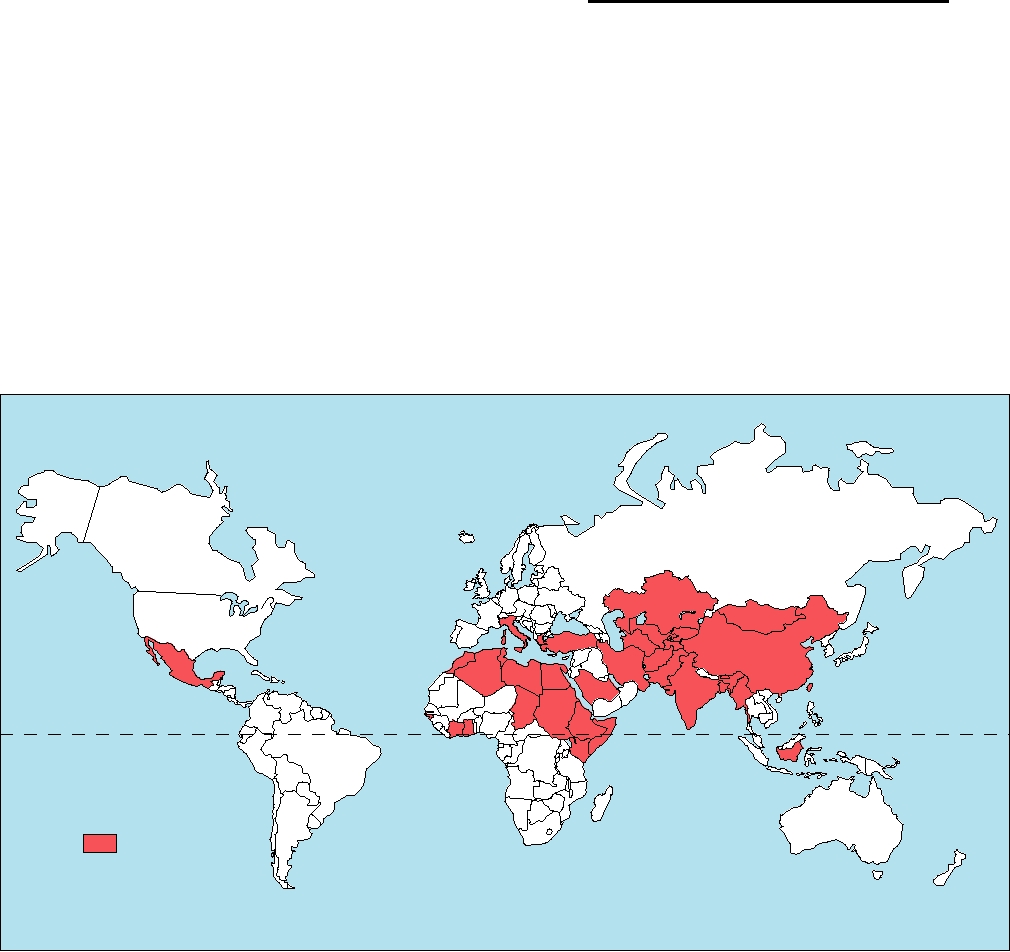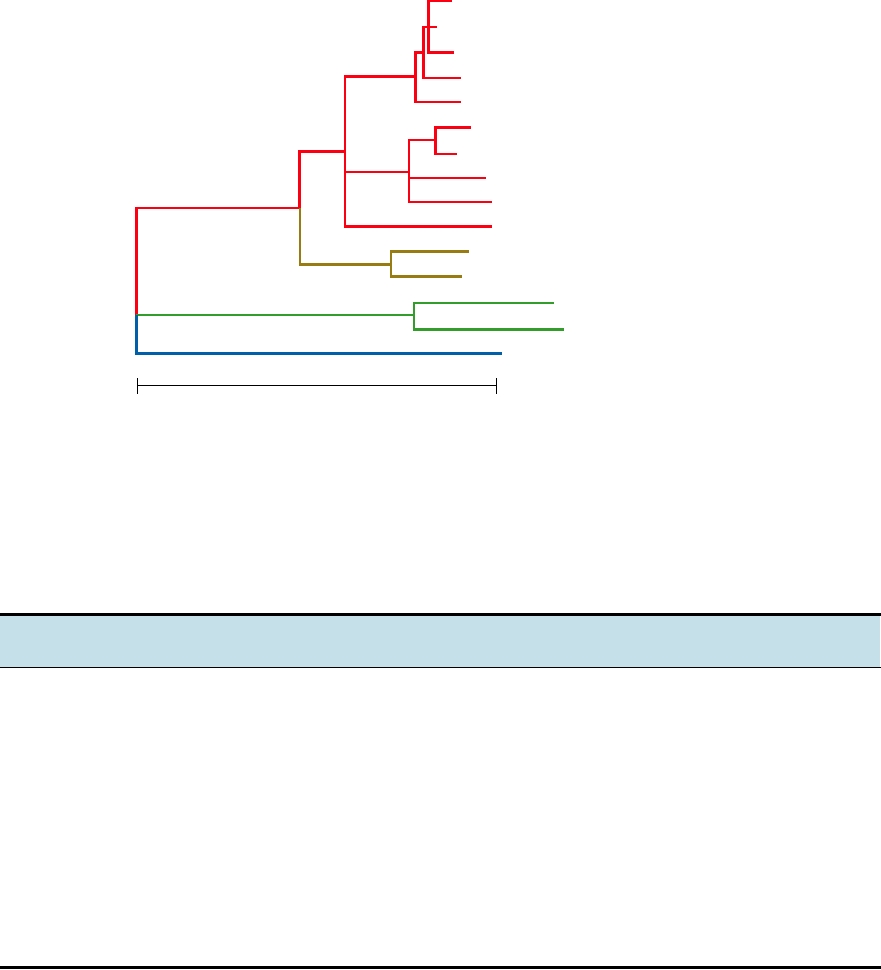and caliciviruses, the virus has a wide host range, infecting
fatality rate is low (<1%), with the prominent exception that
a variety of mammals. The virus is widespread in pigs, both
the fatality rate in pregnant women can be 20%. There is no
domestic and wild, and pigs appear to be the major reser-
vaccine or treatment for the virus at present.
voir host for the virus. Thus, transmission of the virus is
An avian HEV is also known. This virus shares about 50%
zoonotic, from animals to humans. In one particularly inter-
nucleotide sequence identity with the mammalian virus. It is
esting study in Japan, four humans were infected by the virus
an important pathogen of commercial broiler chickens, but
upon eating raw deer meat from a wild deer. The nucleotide
does not appear to infect mammals.
sequence of the virus isolated from the humans differed
from the sequence of virus isolated from the deer by fewer
FAMILY ASTROVIRIDAE
than 8 nucleotides, clearly showing that the deer served as
the source of the infection. From a wild boar captured in the
same area a year later, virus was isolated that differed by up
Astroviruses constitute a recently described family of
to 23 nucleotides from the deerhuman viruses. It has been
animal viruses. Some of these are human viruses that cause
found that in Japan only about 1% of deer are positive for
gastroenteritis, but astroviruses for cattle, pigs, sheep, and
HEV antibodies, whereas 3 of 7 wild boars were found to
ducks are also known (Table 3.8). The name comes from the
be positive and almost 100% of Japanese pigs are positive
Greek word for star, from starlike structures on the surface
by 6 months of age. Thus, pigs are the major reservoir and
of the virion. Unlike the human caliciviruses, the human
spread the virus to other mammals as well as to humans.
astroviruses will grow in cultured cells, and progress on
HEV is found in Asia, Africa, Southern Europe, and
understanding their molecular biology has been more rapid.
Mexico, where it causes thousands of cases of hepatitis each
They are small viruses, 30 nm, with icosahedral symmetry,
year (Fig. 3.13). A dendrogram of various geographical
and a genome of 7 kb.
isolates of HEV illustrates that the New World strain has
The replicase proteins of astroviruses are translated from
diverged significantly from the Asian isolates (Fig. 3.14).
the genomic RNA as two polyproteins (Fig. 3.15). The smaller
Thus, there is little or no circulation of virus between dif-
translation product (1a) terminates at a stop codon; ribo-
ferent geographic regions. The disease is severe but the
somal frameshifting (Chapter 1) at a retrovirus-like slippery
Equator
Countries with Epidemic or
Endemic Hepatitis E
FIGURE 3.13 Worldwide incidence of epidemic and endemic hepatitis E. In addition, serosurveys indicate that 12%
of blood donors in United States and Western Europe have detectable IgG antibodies to hepatitis E. Adapted from Fields et
al. (1996) p. 2838.
87-China-A
87-China-B
87-China-C
87-Pakistan
87-China-D
89-Myanmar (Burma)
1
82-(Burma)
90-India (Hyderabad)
I
93-India (Madras)
92-Fulminant (UK traveler to India)
93-Egypt
2
94-Egypt
96-USA-swine
II
95-USA-human
III
87-Mexico
10% nucleotide divergence
FIGURE 3.14 Phylogenetic tree of HEV isolates based on the complete sequences of ORF2 (1983 nt), encoding the coat
protein. Isolates are listed by year and location of isolation. Branch lengths are proportional to the evolutionary distance
between sequences. Roman numerals are used to denote genotypes (<85% nucleotide sequence identity), and arabic
numbers denote subgenotypes (<92.5% nucleotide sequence identity). The genetic groupings of the HEV strains reflect the
geographic relationships of the places from which they were isolated, showing that the viruses are geographically isolated
and do not circulate over wide areas. Adapted from Figure 1 in Tsarev et al. (1999).
TABLE 3.8 Astroviridae
Virus name
Genus/membersa
abbreviation
Usual host(s)
Transmission
Disease
Mamastrovirus
Human astrovirus (5)
HAstV
Humans
Water-borne, oralfecal
Gastroenteritis
Bovine astrovirus (2)
BAstV
Cattle
Water-borne, oralfecal
Gastroenteritis
Feline astrovirus
FAstV
Cats
Water-borne, oralfecal
Gastroenteritis
Ovine astrovirus 1
OAstV
Sheep
Water-borne, oralfecal
Gastroenteritis
Porcine astrovirus 1
PAstV
Swine
Water-borne, oralfecal
Gastroenteritis
Avastrovirus
Duck astrovirus
DAstV
Ducks
Water-borne, oralfecal
Fatal hepatitis
in ducklings
Turkey astrovirus
TAstV
Turkeys
Water-borne, oralfecal
Gastroenteritis
a
All astroviruses identified are worldwide in distribution.
sequence allows readthrough into a second reading frame (1b)
Epidemiological studies suggest that astroviruses are an
to produce a longer polyprotein (1ab). A subgenomic mRNA
important cause of acute human gastroenteritis worldwide.
is translated into the capsid protein of the virus.
A summary of virus families known to contain viruses
Astroviruses encode a 3C-like serine protease (with serine
that cause gastroenteritis and acute diarrhea in humans as
in the active site) and an RNA polymerase related to other
well as other vertebrates is shown in Table 3.9. In addi-
viral RNA polymerases, but there is no evidence for a heli-
tion to the picornaviruses, caliciviruses, and astroviruses
case or a capping enzyme. It has been suggested that astro-
described earlier, some adenoviruses and reoviruses also
viruses contain a VPg, consistent with the lack of a capping
cause human gastroenteritis, and members of additional
enzyme, but no domain encoding a VPg has been identified
families may also cause human gastroenteritis, as shown
in the genome.
in the table. In addition to the viruses listed, there may yet
Search WWH :



